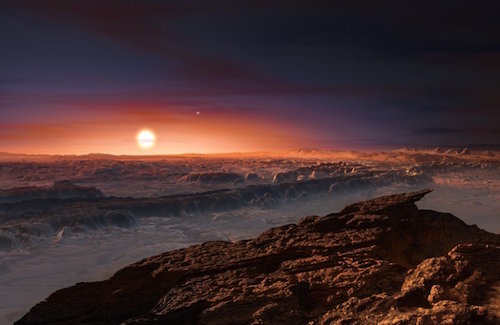 Evolution
Evolution
 Intelligent Design
Intelligent Design
 Physics, Earth & Space
Physics, Earth & Space
Put Up or Shut Up for Evolution? Nearest “Habitable” Planet Found Orbiting Proxima Centauri

For materialists, the origin of life and the evolution of complex, even intelligent creatures needs to be a sure thing, or close to it, given a suitable planetary environment.
Reportedly Earth-like exoplanets discovered up until now have been far away and difficult to check for signs of alien biology. Not so Proxima b, reported today in Nature (“A terrestrial planet candidate in a temperate orbit around Proxima Centauri“). It orbits a red dwarf star, Proxima, in the nearby Alpha Centauri star system. The planet is the closest possibly Earth-like world to Earth, in distance, to be found so far. Only 4.2 light years away.
From the Abstract:
Here we report observations that reveal the presence of a small planet with a minimum mass of about 1.3 Earth masses orbiting Proxima with a period of approximately 11.2 days at a semi-major-axis distance of around 0.05 astronomical units. Its equilibrium temperature is within the range where water could be liquid on its surface.
Media coverage focuses on the potential for habitability:
-
“Potentially Habitable Planet Found Orbiting Star Closest to Sun” (National Geographic)
-
“Proxima Centauri planet could tell us about alien life in the universe” (The Guardian)
-
“Possibly habitable planet found orbiting nearest star” (CBS News)
It’s a “game changer,” the “holy grail,” only a “hop, skip, and a jump” away, physicist Michio Kaku tells CBS, which characterizes the planet as a possible “Earth 2.0.”
A closer look, though, reveals trouble in paradise. Liquid water — perhaps, but also a surface assailed by “ultraviolet and X-ray flares,” and a climate not well suited to make Earthlings, at least, feel at home. From Science Daily:
Despite the temperate orbit of Proxima b, the conditions on the surface may be strongly affected by the ultraviolet and X-ray flares from the star — far more intense than the Earth experiences from the Sun [4].
Two separate papers discuss the habitability of Proxima b and its climate. They find that the existence of liquid water on the planet today cannot be ruled out and, in such case, it may be present over the surface of the planet only in the sunniest regions, either in an area in the hemisphere of the planet facing the star (synchronous rotation) or in a tropical belt (3:2 resonance rotation). Proxima b’s rotation, the strong radiation from its star and the formation history of the planet makes its climate quite different from that of the Earth, and it is unlikely that Proxima b has seasons.
Even so, they say, “Proxima b will be a prime target for the hunt for evidence of life elsewhere in the Universe.”
All is celebration until it sinks in that with every discovery of a seemingly near-Earth-like planet, evolutionism comes a step closer to a put-up-or-shut-up moment. Unguided evolution must be baked into the cake, not only on Earth but anywhere like Earth. It must be something blind forces accomplish readily. If it could ever be known that only one planet in the cosmos was graced with biology, that would pose an insurmountable difficulty for Darwinists.
Imagining life elsewhere, in the absence of evidence, is more comfortable when Earth-like planets are conjectural, distant, or both. The planet orbiting Proxima Centauri is uncomfortably nearby. The more Earth-like the exoplanet, the closer it is and the easier to probe for any signature of life, the more materialism may be forced to consider the possibility that a key premise was in error.
Intelligent design can live easily with the idea of inhabited worlds beyond Earth. The more difficult “evolution” looks, though, the more it looks like design.
Image: Proxima b, artist’s vision, by ESO/M. Kornmesser via Science Daily.
